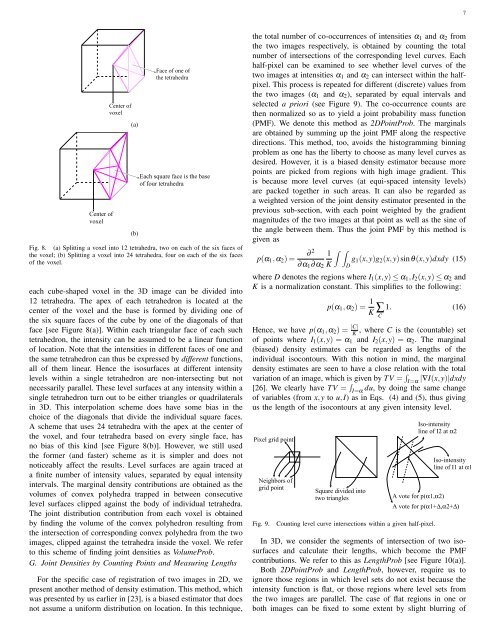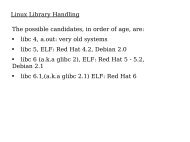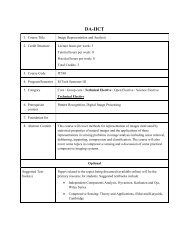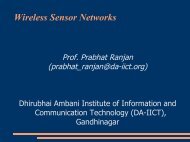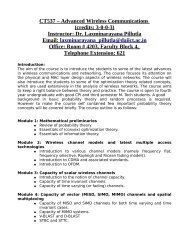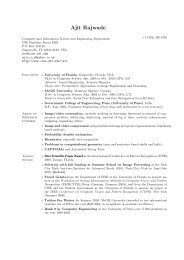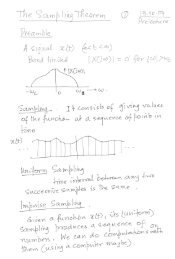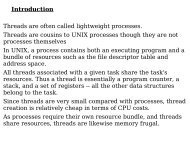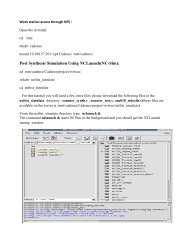Probability Density Estimation using Isocontours and Isosurfaces ...
Probability Density Estimation using Isocontours and Isosurfaces ...
Probability Density Estimation using Isocontours and Isosurfaces ...
You also want an ePaper? Increase the reach of your titles
YUMPU automatically turns print PDFs into web optimized ePapers that Google loves.
Center of<br />
voxel<br />
Center of<br />
voxel<br />
(a)<br />
(b)<br />
Face of one of<br />
the tetrahedra<br />
Each square face is the base<br />
of four tetrahedra<br />
Fig. 8. (a) Splitting a voxel into 12 tetrahedra, two on each of the six faces of<br />
the voxel; (b) Splitting a voxel into 24 tetrahedra, four on each of the six faces<br />
of the voxel.<br />
each cube-shaped voxel in the 3D image can be divided into<br />
12 tetrahedra. The apex of each tetrahedron is located at the<br />
center of the voxel <strong>and</strong> the base is formed by dividing one of<br />
the six square faces of the cube by one of the diagonals of that<br />
face [see Figure 8(a)]. Within each triangular face of each such<br />
tetrahedron, the intensity can be assumed to be a linear function<br />
of location. Note that the intensities in different faces of one <strong>and</strong><br />
the same tetrahedron can thus be expressed by different functions,<br />
all of them linear. Hence the isosurfaces at different intensity<br />
levels within a single tetrahedron are non-intersecting but not<br />
necessarily parallel. These level surfaces at any intensity within a<br />
single tetrahedron turn out to be either triangles or quadrilaterals<br />
in 3D. This interpolation scheme does have some bias in the<br />
choice of the diagonals that divide the individual square faces.<br />
A scheme that uses 24 tetrahedra with the apex at the center of<br />
the voxel, <strong>and</strong> four tetrahedra based on every single face, has<br />
no bias of this kind [see Figure 8(b)]. However, we still used<br />
the former (<strong>and</strong> faster) scheme as it is simpler <strong>and</strong> does not<br />
noticeably affect the results. Level surfaces are again traced at<br />
a finite number of intensity values, separated by equal intensity<br />
intervals. The marginal density contributions are obtained as the<br />
volumes of convex polyhedra trapped in between consecutive<br />
level surfaces clipped against the body of individual tetrahedra.<br />
The joint distribution contribution from each voxel is obtained<br />
by finding the volume of the convex polyhedron resulting from<br />
the intersection of corresponding convex polyhedra from the two<br />
images, clipped against the tetrahedra inside the voxel. We refer<br />
to this scheme of finding joint densities as VolumeProb.<br />
G. Joint Densities by Counting Points <strong>and</strong> Measuring Lengths<br />
For the specific case of registration of two images in 2D, we<br />
present another method of density estimation. This method, which<br />
was presented by us earlier in [23], is a biased estimator that does<br />
not assume a uniform distribution on location. In this technique,<br />
the total number of co-occurrences of intensities α1 <strong>and</strong> α2 from<br />
the two images respectively, is obtained by counting the total<br />
number of intersections of the corresponding level curves. Each<br />
half-pixel can be examined to see whether level curves of the<br />
two images at intensities α1 <strong>and</strong> α2 can intersect within the halfpixel.<br />
This process is repeated for different (discrete) values from<br />
the two images (α1 <strong>and</strong> α2), separated by equal intervals <strong>and</strong><br />
selected a priori (see Figure 9). The co-occurrence counts are<br />
then normalized so as to yield a joint probability mass function<br />
(PMF). We denote this method as 2DPointProb. The marginals<br />
are obtained by summing up the joint PMF along the respective<br />
directions. This method, too, avoids the histogramming binning<br />
problem as one has the liberty to choose as many level curves as<br />
desired. However, it is a biased density estimator because more<br />
points are picked from regions with high image gradient. This<br />
is because more level curves (at equi-spaced intensity levels)<br />
are packed together in such areas. It can also be regarded as<br />
a weighted version of the joint density estimator presented in the<br />
previous sub-section, with each point weighted by the gradient<br />
magnitudes of the two images at that point as well as the sine of<br />
the angle between them. Thus the joint PMF by this method is<br />
given as<br />
∂ 2 <br />
1<br />
p(α1,α2) = g1(x,y)g2(x,y)sinθ(x,y)dxdy (15)<br />
∂α1∂α2 K D<br />
where D denotes the regions where I1(x,y) ≤ α1,I2(x,y) ≤ α2 <strong>and</strong><br />
K is a normalization constant. This simplifies to the following:<br />
p(α1,α2) = 1<br />
K ∑1. (16)<br />
C<br />
Hence, we have p(α1,α2) = |C|<br />
K , where C is the (countable) set<br />
of points where I1(x,y) = α1 <strong>and</strong> I2(x,y) = α2. The marginal<br />
(biased) density estimates can be regarded as lengths of the<br />
individual isocontours. With this notion in mind, the marginal<br />
density estimates are seen to have a close relation with the total<br />
variation of an image, which is given by TV = <br />
I=α |∇I(x,y)|dxdy<br />
[26]. We clearly have TV = <br />
I=α du, by doing the same change<br />
of variables (from x,y to u,I) as in Eqs. (4) <strong>and</strong> (5), thus giving<br />
us the length of the isocontours at any given intensity level.<br />
Pixel grid point<br />
Neighbors of<br />
grid point<br />
Square divided into<br />
two triangles<br />
Iso-intensity<br />
line of I2 at α2<br />
A vote for p(α1,α2)<br />
7<br />
Iso-intensity<br />
line of I1 at α1<br />
A vote for p(α1+∆,α2+∆)<br />
Fig. 9. Counting level curve intersections within a given half-pixel.<br />
In 3D, we consider the segments of intersection of two isosurfaces<br />
<strong>and</strong> calculate their lengths, which become the PMF<br />
contributions. We refer to this as LengthProb [see Figure 10(a)].<br />
Both 2DPointProb <strong>and</strong> LengthProb, however, require us to<br />
ignore those regions in which level sets do not exist because the<br />
intensity function is flat, or those regions where level sets from<br />
the two images are parallel. The case of flat regions in one or<br />
both images can be fixed to some extent by slight blurring of


